If you want to build greater thickness and strength in your upper pecs, then you should add incline dumbbell bench press to your training regime. Having a well-developed upper chest contributes to the fullness of the upper body and has functional benefits.
The incline dumbbell chest press is also easy to learn and progressively overload, which is why it’s used to good effect in both novice and advanced training programs.
In this article, you will learn everything you need to know about how to perform the incline dumbbell bench press correctly.
You will also learn its benefits, how to avoid common mistakes, and what are the best variation of incline dumbbell chest press and how to do them. You will also learn some of the best alternatives of it.
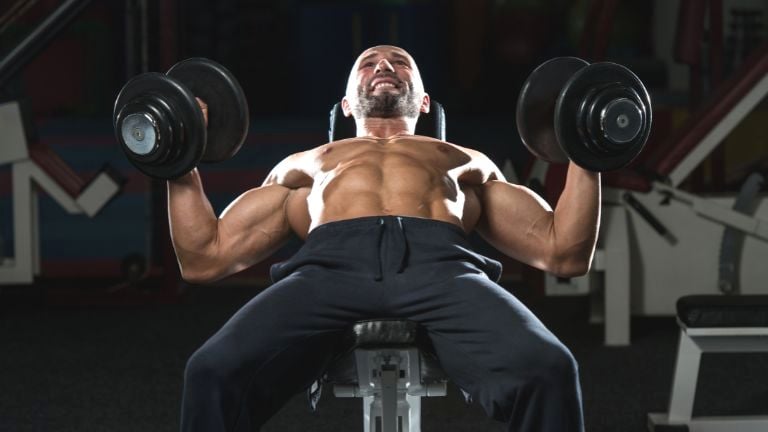
- Know About Chest Muscles
- What Is the Incline Dumbbell Chest Press?
- Incline Dumbbell Chest Press Angle
- Note
- Incline Dumbbell Chest Press Muscles Worked
- How To Do Incline Dumbbell Bench Press
- 1. Set Up The Bench
- 2. Starting Position
- 3. Grip and Elbow Position
- 4. Performing the Press
- Sets And Reps For Incline Dumbbell Press
- Sets
- Reps
- Incline Dumbbell Chest Press Proper Form and Mistakes
- Best Variations of Incline Dumbbell Chest Press
- 1. Dumbbell Incline Alternate Press
- 2. Reverse Grip Incline Dumbbell Bench Press
- 3. Incline Dumbbell Squeeze Press
- Best Alternate of Incline Dumbbell Chest Press
- 1. Incline Bench Press
- 2. Decline Push-Up
- 3. Low Cable Fly (Low To High Cable Fly)
- 4. Incline Dumbbell Fly
- 5. Standing Upward Chest Fly
- Incline Dumbbell Press Benefits
- Frequently asked question
- Incline Dumbbell Press Vs. Flat Dumbbell Press
- Is the incline bench 30 or 45 degrees?
- What muscles does incline bench press work?
- How does incline bench press help you?
- Takeaways
- References
- 7 Best Incline Chest Press Variations To Build Mass
Know About Chest Muscles
To effectively train the upper chest, first we need to have a closer look at the chest anatomy and how to train it.
The chest muscle is commonly known as the pectoralis (pecs) muscle, which is divided into upper and lower sections. The upper region of the chest is the hardest area of the chest to build.
The pectoralis major has two functional subdivisions –the upper and lower regions.
- The upper region is referred to as the sternoclavicular head because of its attachment to the clavicle.
- The lower regions are sometimes referred to as the sternocostal head because of their attachment to the ribs.
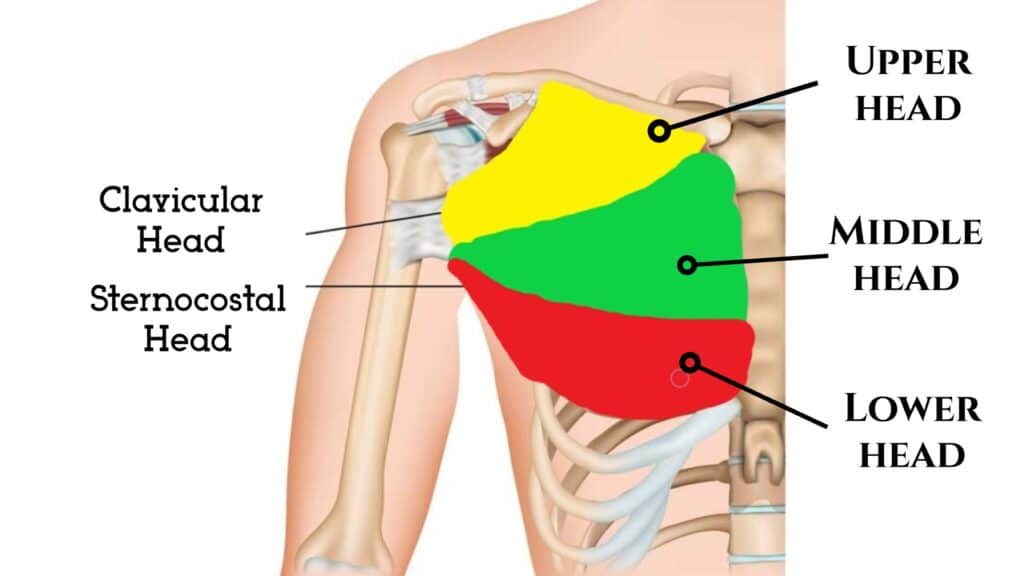
What Is the Incline Dumbbell Chest Press?
The incline dumbbell bench press aka dumbbell incline Chest press is an upper body workout that engages the upper pec muscles, the triceps, and the anterior deltoid muscles of the shoulders.
The angle of the adjustable bench in this variation puts more tension on your upper chest muscles than a flat bench press would.
Incline Dumbbell Chest Press Angle
The incline bench press is one of the best upper chest exercises, but there’s one major problem: the front deltoid likes to dominate the movement, which prevents us from getting the maximum benefit out of it.
The anterior deltoids and the upper chest are very close to each other, which means that one of the two can start dominating the other if we don’t do the exercise correctly. When you do the incline bench press, it’s important to get the angle of the bench correct.
What angles should I use during the incline dumbbell bench press to hit the upper chest the most? Or whether it’s better to do High Incline and Low Incline Dumbbell chest presses.
Research shows that doing the Incline bench press at a 30-degree angle is the best way to work on the upper part of your chest.
Even though 30 degrees may seem like a small angle, it is the proper angle to train your upper pecs and minimize the effect on the anterior deltoid muscles.
If you set the incline bench press angle to 60 degrees, that people will use for an incline bench press, then you’re going to shift the focus from the upper chest to the anterior deltoid.
An upright position will maximize the attention that the front delts get because the arms will move in a straight line up against gravity in an overhead pressing motion.

Note
For proper stimulation of the upper chest muscles, keep the angle of the bench at 30 degrees. If you want to increase the angle further, please avoid going beyond 45 degrees, as this will shift the focus to the anterior deltoid.
Incline Dumbbell Chest Press Muscles Worked
The incline dumbbell bench press primarily works the upper pectoralis major muscles, in addition to its target to the main pec muscle.
The incline chest press has the involvement of several synergist muscles, these muscles include,
A handful of other muscles worked or play the role of stabilizer muscles, including your
- Biceps brachii,
- Brachialis,
- Triceps brachii,
- Wrist flexors,
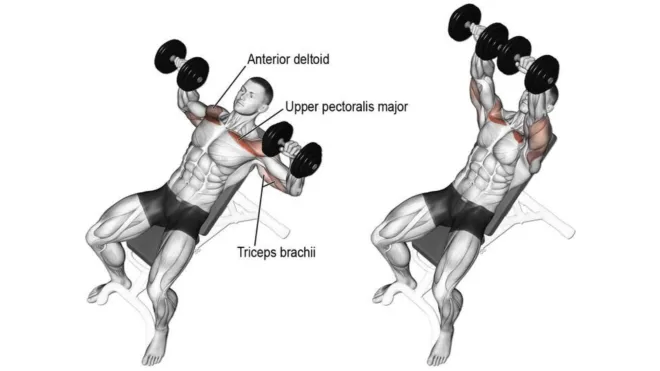
How To Do Incline Dumbbell Bench Press
If you’re looking for a straightforward dumbbell upper chest exercises to add to your routine, the Incline dumbbell press is a great staple exercise to get you started.
Just like the Incline bench press, the Incline dumbbell chest press works mostly on the upper pecs, but dumbbells allow full range of motion, and therefore in some ways better than the bench press. It adds an extra range of motion at the top for complete chest development.
Here’s a step-by-step guide on how to perform this exercise with proper form:
1. Set Up The Bench
- Adjust the bench to an incline position, typically between 30 to 45 degrees. A steeper incline will involve the shoulders more, so a slight incline is preferred to keep the focus on the upper chest.
2. Starting Position
- Sit down on the bench with a dumbbell in each hand, resting them on your thighs.
- As you lay back, use your thighs to help lift the dumbbells to a position slightly wider than shoulder-width apart, at chest level.
- Your feet should be firmly planted on the ground, creating a stable foundation.
3. Grip and Elbow Position
- Hold the dumbbells with a palms facing forward.
- Your elbows should be angled slightly towards your torso (about 45 degrees from your body).
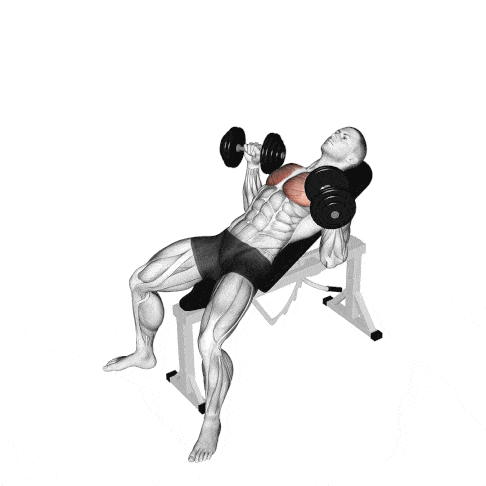
4. Performing the Press
- Inhale and lower the dumbbells slowly and controlled. Let your elbows drop until the dumbbells are roughly at chest level.
- Make sure the movement is controlled and that the dumbbells don’t bounce off your chest.
- As you exhale, press the dumbbells back up to the starting position by contracting your chest muscles. Think about squeezing your chest at the top of the movement.
- Repeat the desired number of reps and sets.
Sets And Reps For Incline Dumbbell Press
Training volume refers to the total amount of work you perform during a workout, including the number of sets, reps, and weight used.
Of course, the number of sets and reps will be determined based on your fitness journey, but here is a great starting point.
Sets
According to the latest scientific evidence, 12–20 weekly sets per muscle group may optimize muscle growth.
- Beginners (with a year or less of training) should aim for about 12 weekly sets.
- An Intermediate trainee (with two to four years of training) can increase the volume to 16 sets per week.
- An advanced trainee (four or more years of training) may be able to get in up to 20 weekly sets.
When a certain amount of volume stops being effective and your progress stalls, you can add sets to increase volume and use that as a driver of renewed progress.
Reps
The best rep ranges and loads to work with.
- For muscle endurance: Aim for 15-20+ reps, with a moderate amount of resistance.
- For muscle strength: 6-10 reps, with a heavier amount of resistance.
- For muscle hypertrophy (increased muscle size): Aim for 3-4 sets of 8-12 reps, with a moderate to heavy amount of resistance.
It’s best to start with fewer reps and sets at first, and then increase them as you get stronger.
Incline Dumbbell Chest Press Proper Form and Mistakes
Proper exercise technique is essential to ensure the safety and effectiveness of an exercise program.
- Exhale whilst pushing dumbbells upwards and do in a controlled manner.
- For the Incline dumbbell press, it is best to set the bench at about 30 degrees inclined. Do not go more upright as the stress shifts more to the shoulders rather than the chest area.
- Keep a controlled motion and avoid jerky movements.
- Always use weights that you can handle comfortably.
- Keep the tension on your chest as you press the weight up.
- Always use the longest range of motion possible and control the dumbbells throughout the set.
- Ultimately, your results will depend on your ability to adequately recover from your workouts. It is recommended that you allow at least 36 to 48 hours of rest before training the same muscle groups again, in order to allow for sufficient recovery.
- Ensure you maintain some tension in your abs and don’t allow your lower back to excessive arch.
- Keep your feet flat on the floor and don’t allow your lower body to move during the set.
- Vary bench angles to hit different angles of the chest, but do not go beyond 45 degrees.
Best Variations of Incline Dumbbell Chest Press
The incline dumbbell bench press can be done in different ways to suit your fitness level.
If you are new to performing an incline dumbbell press, you may want to apply a few modifications to make the exercise easier. One way to counter this problem is to adjust the incline of the bench so that it is completely flat. Another is to use a lighter weight.
If you are looking for a more advanced variation to stimulate different muscle fibers in the chest, then try dumbbell incline alternate press, and reverse grip incline dumbbell bench press. You can make it more difficult by increasing the bench inclination and using heavier weight. But focus on form while doing the same.
1. Dumbbell Incline Alternate Press
The Dumbbell Incline alternate press builds size and strength in your chest, specifically targeting the upper chest. Armed with an incline bench and a pair of dumbbells, this exercise can bolster your entire upper body fitness routine.
This is one of the best two-arm upper chest exercises that you can do with a dumbbell during your upper chest workout.

How To Do Dumbbell Incline Alternate Chest Press
- Grab a pair of dumbbells, and lie on an incline bench (30-45 degree inclined).
- Hold a pair of dumbbells directly above your chest with your arms fully extended and your palms facing outward.
- Pull your shoulder blades together, slightly stick out your chest, and lower both dumbbells to the sides of your chest.
- Now, press one dumbbell upward, keeping the other at your side.
- Then, as you lower the dumbbell, press the other one upward.
Tips
- Make sure to utilize a full range of motion throughout the exercise.
- Keep both keep firmly placed on the floor throughout the exercise.
- Vary bench angles to hit different angles of the chest.
2. Reverse Grip Incline Dumbbell Bench Press
The reverse-grip incline dumbbell chest press is a very effective compound exercise which targets the upper chest muscles for maximum muscle and strength gains.
Now, it’s an unconventional movement compared to the regular dumbbell press with an overhand grip, but it’s beneficial for emphasizing the upper chest muscles due to the reverse hand position.
A group of Canadian scientists found that the muscle activity of the upper pecs in weight-trained subjects performing reverse-grip bench presses was more than 30% greater than when they did standard-grip bench press.

How To Do Reverse Grip Incline Dumbbell Bench Press
- Grab a pair of dumbbells, and lie on an incline bench (30-45 degree inclined).
- Extend the dumbbell above your chest.
- Keep your elbow slightly bent, lower the weight down until it is about chest level and hold.
- Bring your arm back toward the midline of your body, focusing on using your upper pec muscles to draw them back together.
- Repeat for the desired number of reps.
Tips
- Beginners should start light and practice good form before training heavy.
- Keep both keep firmly placed on the floor throughout the exercise.
3. Incline Dumbbell Squeeze Press
The incline dumbbell squeeze press is one of the most effective chest pressing exercises which targets the Inner chest and upper chest.
During the squeeze press, the dumbbells are kept in contact with each other at all times, and you’re actively squeezing them inward (against each other) as hard as possible.
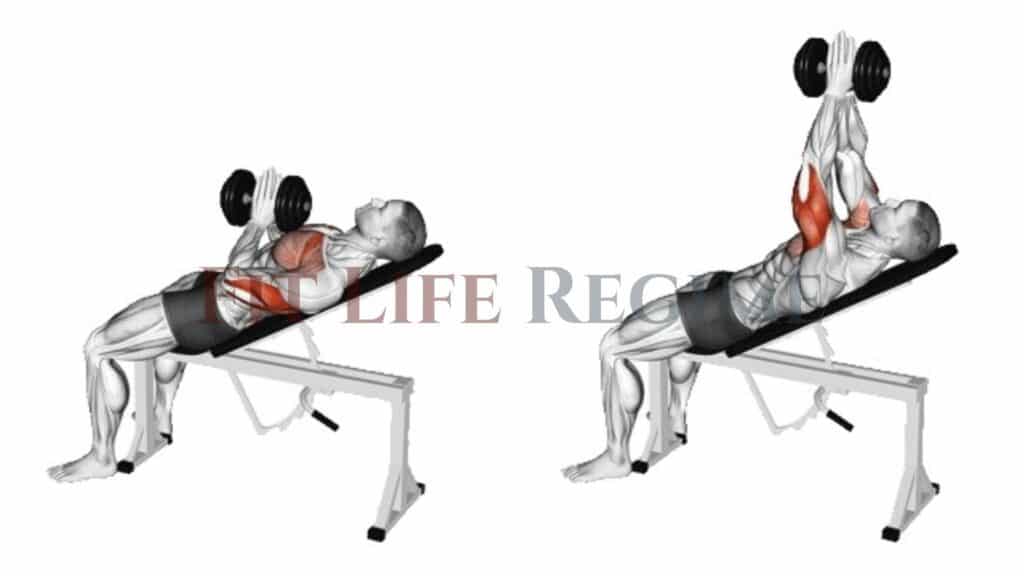
How To Do Incline Dumbbell Squeeze Press
- Take the one dumbbell and grab it with both hands. Then, lay down on the incline bench.
- Place the dumbbell at center, and lift them up over your chest.
- Lower the dumbbell to touch your chest, and then push the dumbbell back up.
- Repeat for the desired number of repetitions.
Tips
- Breathe out on the way up.
- Maintain more tension through the pecs by not locking out the elbows entirely.
Best Alternate of Incline Dumbbell Chest Press
Before, we take a look at the best incline dumbbell chest press alternatives. We must keep in mind that a good alternative to the Incline dumbbell bench press will be able to satisfy the following criteria:
- Activate the chest muscle groups, which are trained in the Incline dumbbell press.
- Isolate the muscle groups during execution.
- Train the chest muscle through a longer range of motion
1. Incline Bench Press
The incline bench press is a classic exercise and is the best alternate to the incline dumbbell bench press when focusing on the upper chest. It helps build massive upper pecs and overall strength.
It is the best exercise to develop muscle mass in the upper and middle Pectoral region.
2. Decline Push-Up
If you’re looking for a bodyweight alternative to the incline dumbbell press exercise that helps you build upper pecs, then the decline push-up is a great staple exercise to get you started.
It is similar to normal push-ups, but with your legs on a bench. Although this is called the Decline push-up, it focuses more on the upper pecs.
3. Low Cable Fly (Low To High Cable Fly)
If you have access to a cable setup, I recommend you try it as an alternative to dumbbell incline press. The standing low to high cable fly is a used to strengthen the pushing muscles of the body including the chest, tricep, and shoulders.
Low to High Cable Fly exercise helps to develop and define upper and inner pectoral muscles. Cable provides constant resistance and helps develop central chest muscles and provides the much-needed stress and inner pecs, for which bodybuilders crave.
4. Incline Dumbbell Fly
The incline dumbbell fly is a variation of the dumbbell fly performed with an incline bench. This is one of the best chest exercises that you can do during your upper pecs workout.
Do not just perform a basic flat bench fly, but also add an incline variation because the incline bench position allows for the isolation of the harder-to-develop upper pectorals.
5. Standing Upward Chest Fly
If you are searching for an alternative to incline dumbbell chest press, standing dumbbell chest fly is a good exercise to target your upper chest. With just a pair of dumbbells, you can strengthen your chest and make it appear broader and more developed.
This exercise is like a front raise that you would do for your shoulders, but with a simple twist of the wrists that makes it an effective chest exercise. For this one, you will require a dumbbell in each hand.
Incline Dumbbell Press Benefits
There are several reasons that motivate you to do incline dumbbell bench press, and I’ve mentioned some of them below.
- Dumbbell Incline chest press exercises require more balance than barbells or machines that can lead to greater muscle fiber recruitment.
- Incline DB Press with dumbbell allows unilateral training (training one limb at a time), increases core stability, and improves muscular imbalances.
- Dumbbell incline chest press allows for greater joint safety and stabilization and allows the joints to move naturally within their range of motion.
- Dumbbell incline press variations allow for a greater range of movement (ROM), which leads to an increased number of muscle fibers recruited.
- It affords a greater level of variety, which prevents physical and mental burnout.
- It requires more muscular control than barbells, enhancing kinaesthetic awareness.
Frequently asked question
Incline Dumbbell Press Vs. Flat Dumbbell Press
The main difference between the incline dumbbell chest press and the flat dumbbell press is that the incline dumbbell press emphasizes more the clavicular (upper) head of the pecs. Whereas the flat dumbbell press emphasizes both head, the clavicular (upper) and sternocostal (lower) head.
It makes sense, then, to include a mix of incline and flat pressing in your workout routine if you want well-developed, proportionate pecs.
Is the incline bench 30 or 45 degrees?
Research shows that the correct angle of the Incline Bench Press should be 30 degrees from flat to target the upper chest. So, it is best to set the bench at about 30 degrees inclined. It is important not to go too upright because then the stress will shift to the shoulders rather than the chest.
What muscles does incline bench press work?
The incline bench press is one of the best upper chest exercises, but you need to ensure that you’re not allowing your front delts to dominate the movement. To avoid this, be sure to use the correct bench angle and squeeze your shoulder blades during the movement.
How does incline bench press help you?
The incline bench press is one of the best upper chest exercises, but you need to ensure that you’re not allowing your front delts to dominate the movement.
Takeaways
Dumbbell incline chest press exercises are highly recommended for anyone interested in building upper body strength and gaining muscle size.
It is easy to do and requires no more scientific details and fancy equipment. If you consistently do dumbbell incline chest press exercises with other variation of chest press, you will see results.
References
- Influence of bench angle on upper extremity muscular activation during bench press exercise. Lauver, J. D., Cayot, T. E., & Scheuermann, B. W. (2015). European Journal of Sport Science, 16(3), 309-316. doi:10.1080/17461391.2015.1022605. URL: https://www.tandfonline.com/doi/full/10.1080/17461391.2015.1022605, accessed on 24.08.2020
- An Electromyography Analysis of 3 Muscles Surrounding the Shoulder Joint During the Performance of a Chest Press Exercise at Several Angles. Trebs, A. A., Brandenburg, J. P., & Pitney, W. A. (2010). Journal of Strength and Conditioning Research, 24(7), 1925-1930. doi:10.1519/jsc.0b013e3181ddfae7
7 Best Incline Chest Press Variations To Build Mass

Manish brings over 10 years of hands-on experience in weight lifting and fat loss to fitness coaching. He specializes in gym-based training and has a lot of knowledge about exercise, lifting technique, biomechanics, and more.
Through “Fit Life Regime,” he generously shares the insights he’s gained over a decade in the field. His goal is to equip others with the knowledge to start their own fitness journey.
